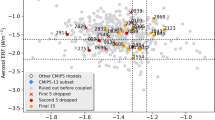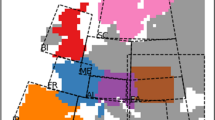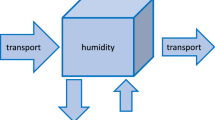Abstract
In this study the relationship between climate model biases in the control climate and the simulated climate sensitivity are discussed on the basis of perturbed physics ensemble simulations with a globally resolved energy balance (GREB) model. It is illustrated that the uncertainties in the simulated climate sensitivity (estimated by the transient response to CO2 forcing scenarios in the twenty first century or idealized 2 × CO2 forcing experiments) can be conceptually split into two parts: a direct effect of the perturbed physics on the climate sensitivity independent of the control mean climate and an indirect effect of the perturbed physics by changing the control mean climate, which in turn changes the climate sensitivity, as the climate sensitivity itself is depending on the control climate. Biases in the control climate are negatively correlated with the climate sensitivity (colder climates have larger sensitivities), if no physics are perturbed. Perturbed physics that lead to warmer control climate, would in average also lead to larger climate sensitivities, if the control climate is held at the observed reference climate by flux corrections. Thus the effects of control biases and perturbed physics are opposing each other and are partially cancelling each other out. In the GREB model the biases in the control climate are the more important effect for the regional climate sensitivity uncertainties, but for the global mean climate sensitivity both, the biases in the control climate and the perturbed physics, are equally important.












Similar content being viewed by others
References
Bony S, Colman R, Kattsov VM, Allan RP, Bretherton CS, Dufresne JL, Hall A, Hallegatte S, Holland MM, Ingram W, Randall DA, Soden BJ, Tselioudis G, Webb MJ (2006) How well do we understand and evaluate climate change feedback processes? J Clim 19:3445–3482
Bretherton CS, Widmann M, Dymnikov VP, Wallace JM, Blade I (1999) The effective number of spatial degrees of freedom of a time-varying field. J Clim 12:1990–2009
Brierley CM, Thorpe AJ, Collins M (2009) An example of the dependence of the transient climate response on the temperature of the modelled climate state. Atmos Sci Lett 10:23–28
Caballero R, Huber M (2013) State-dependent climate sensitivity in past warm climates and its implications for future climate projections. Proc Natl Acad Sci USA 110:14162–14167
Cess RD, Potter GL, Blanchet JP, Boer GJ, Delgenio AD, Deque M, Dymnikov V, Galin V, Gates WL, Ghan SJ, Kiehl JT, Lacis AA, Letreut H, Li ZX, Liang XZ, Mcavaney BJ, Meleshko VP, Mitchell JFB, Morcrette JJ, Randall DA, Rikus L, Roeckner E, Royer JF, Schlese U, Sheinin DA, Slingo A, Sokolov AP, Taylor KE, Washington WM, Wetherald RT, Yagai I, Zhang MH (1990) Intercomparison and Interpretation of climate feedback processes in 19 atmospheric general-circulation models. J Geophys Res Atmos 95:16601–16615
Collins M, Booth BBB, Harris GR, Murphy JM, Sexton DMH, Webb MJ (2006) Towards quantifying uncertainty in transient climate change. Clim Dyn 27:127–147
Colman R, McAvaney B (2009) Climate feedbacks under a very broad range of forcing. Geophys Res Lett 36:L01702
Dommenget D (2007) Evaluating EOF modes against a stochastic null hypothesis. Clim Dyn 28:517–531
Dommenget D (2012) Analysis of the model climate sensitivity spread forced by mean sea surface temperature biases. J Clim 25:7147–7162
Dommenget D, Floter J (2011) Conceptual understanding of climate change with a globally resolved energy balance model. Clim Dyn 37:2143–2165
Dommenget D, Haase S, Bayr T, Frauen C (2014) Analysis of the Slab Ocean El Nino atmospheric feedbacks in observed and simulated ENSO dynamics. Clim Dyn 42:3187–3205
Gleckler PJ, Taylor KE, Doutriaux C (2008) Performance metrics for climate models. J Geophys Res Atmos 113:D06104
Hawkins E, Sutton R (2009) The potential to narrow uncertainty in regional climate predictions. Bull Am Meteorol Soc 90:1095
Hodson DLR, Keeley SPE, West A, Ridley J, Hawkins E, Hewitt HT (2013) Identifying uncertainties in Arctic climate change projections. Clim Dyn 40:2849–2865
Jonko AK, Shell KM, Sanderson BM, Danabasoglu G (2012) Climate feedbacks in CCSM3 under changing CO2 forcing. Part I: adapting the linear radiative kernel technique to feedback calculations for a broad range of forcings. J Clim 25:5260–5272
Manabe S, Bryan K (1985) Co2-induced change in a coupled ocean-atmosphere model and its paleoclimatic implications. J Geophys Res Oceans 90:1689–1707
Meehl GA, Covey C, Delworth T, Latif M, McAvaney B, Mitchell JFB, Stouffer RJ, Taylor KE (2007a) The WCRP CMIP3 multimodel dataset—a new era in climate change research. Bull Am Meteorol Soc 88:1383
Meehl GA, Stocker TF, Collins WD, Friedlingstein P, Gaye AT, Gregory JM, Kitoh A, Knutti R, Murphy JM, Noda A, Raper SCB, Watterson IG, Weaver AJ, Zhao Z-C (eds) (2007b) Global climate projections. Climate change 2007: the physical science basis. Contribution of working group I to the fourth assessment report of the intergovernmental panel on climate change. Cambridge University Press, Cambridge
Meraner K, Mauritsen T, Voigt A (2013) Robust increase in equilibrium climate sensitivity under global warming. Geophys Res Lett 40:5944–5948
Murphy JM, Sexton DMH, Barnett DN, Jones GS, Webb MJ, Collins M (2004) Quantification of modelling uncertainties in a large ensemble of climate change simulations. Nature 430:768–772
Reichler T, Kim J (2008) How well do coupled models simulate today’s climate? Bull Am Meteorol Soc 89:303
Sanderson BM (2011) A multimodel study of parametric uncertainty in predictions of climate response to rising greenhouse gas concentrations. J Clim 24:1362–1377
Sanderson BM, Piani C, Ingram WJ, Stone DA, Allen MR (2008a) Towards constraining climate sensitivity by linear analysis of feedback patterns in thousands of perturbed-physics GCM simulations. Clim Dyn 30:175–190
Sanderson BM, Knutti R, Aina T, Christensen C, Faull N, Frame DJ, Ingram WJ, Piani C, Stainforth DA, Stone DA, Allen MR (2008b) Constraints on model response to greenhouse gas forcing and the role of subgrid-scale processes. J Clim 21:2384–2400
Sausen R, Barthel K, Hasselmann K (1988) Coupled ocean-atmosphere models with flux correction. Clim Dyn 2:145–163
Schneider EK (1996) Flux correction and the simulation of changing climate. Ann Geophys Atmos Hydrosp Space Sci 14:336–341
Shiogama H, Watanabe M, Yoshimori M, Yokohata T, Ogura T, Annan JD, Hargreaves JC, Abe M, Kamae Y, O’ishi R, Nobui R, Emori S, Nozawa T, Abe-Ouchi A, Kimoto M (2012) Perturbed physics ensemble using the MIROC5 coupled atmosphere-ocean GCM without flux corrections: experimental design and results parametric uncertainty of climate sensitivity. Clim Dyn 39:3041–3056
Stainforth DA, Aina T, Christensen C, Collins M, Faull N, Frame DJ, Kettleborough JA, Knight S, Martin A, Murphy JM, Piani C, Sexton D, Smith LA, Spicer RA, Thorpe AJ, Allen MR (2005) Uncertainty in predictions of the climate response to rising levels of greenhouse gases. Nature 433:403–406
Stott PA, Kettleborough JA (2002) Origins and estimates of uncertainty in predictions of twenty-first century temperature rise. Nature 416:723–726
Taylor KE, Stouffer RJ, Meehl GA (2012) An overview of Cmip5 and the experiment design. Bull Am Meteorol Soc 93:485–498
Yokohata T, Webb MJ, Collins M, Williams KD, Yoshimori M, Hargreaves JC, Annan JD (2010) Structural similarities and differences in climate responses to CO2 increase between two perturbed physics ensembles. J Clim 23:1392–1410
Acknowledgments
I like to thank Gab Abramowitz, Tobias Bayr, Claudia Frauen, Thorsten Mauritsen, Erwan Monier and the anonymous referees for their comments and discussions, which helped to improve this article substantially. This work was supported by the ARC Centre of Excellence for Climate System Science (Grant CE110001028).
Author information
Authors and Affiliations
Corresponding author
Rights and permissions
About this article
Cite this article
Dommenget, D. A simple model perturbed physics study of the simulated climate sensitivity uncertainty and its relation to control climate biases. Clim Dyn 46, 427–447 (2016). https://doi.org/10.1007/s00382-015-2591-4
Received:
Accepted:
Published:
Issue Date:
DOI: https://doi.org/10.1007/s00382-015-2591-4




